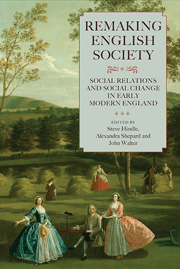Book contents
- Frontmatter
- Contents
- List of Illustrations, Figures, Maps and Tables
- Acknowledgements
- Notes on Contributors
- List of Abbreviations
- 1 The Making and Remaking of Early Modern English Social History
- 2 Brokering Fatherhood: Illegitimacy and Paternal Rights and Responsibilities in Early Modern England
- 3 Gender, Sexuality and the Consumption of Musical Culture in Eighteenth-Century London
- 4 Where was Mrs Turner? Governance and Gender in an Eighteenth-Century Village
- 5 Local Arithmetic: Information Cultures in Early Modern England
- 6 Intoxicants and the Early Modern City
- 7 Food, Drink and Social Distinction in Early Modern England
- 8 Written Obligations, Litigation and Neighbourliness, 1580–1680
- 9 Witchcraft and Neighbourliness in Early Modern England
- 10 Deference, Paternalism and Popular Memory in Early Modern England
- 11 Work, Reward and Labour Discipline in Late Seventeenth-Century England
- 12 Living in Poverty in Eighteenth-Century Terling
- 13 From Commonwealth to Public Opulence: The Redefinition of Wealth and Government in Early Modern Britain
- Appendix: Bibliography of the Published Writings of keith Wrightson from 1974 to 2011
- Index
- Tabula Gratulatoria
- STUDIES IN EARLY MODERN CULTURAL, POLITICAL AND SOCIAL HISTORY
4 - Where was Mrs Turner? Governance and Gender in an Eighteenth-Century Village
Published online by Cambridge University Press: 05 May 2013
- Frontmatter
- Contents
- List of Illustrations, Figures, Maps and Tables
- Acknowledgements
- Notes on Contributors
- List of Abbreviations
- 1 The Making and Remaking of Early Modern English Social History
- 2 Brokering Fatherhood: Illegitimacy and Paternal Rights and Responsibilities in Early Modern England
- 3 Gender, Sexuality and the Consumption of Musical Culture in Eighteenth-Century London
- 4 Where was Mrs Turner? Governance and Gender in an Eighteenth-Century Village
- 5 Local Arithmetic: Information Cultures in Early Modern England
- 6 Intoxicants and the Early Modern City
- 7 Food, Drink and Social Distinction in Early Modern England
- 8 Written Obligations, Litigation and Neighbourliness, 1580–1680
- 9 Witchcraft and Neighbourliness in Early Modern England
- 10 Deference, Paternalism and Popular Memory in Early Modern England
- 11 Work, Reward and Labour Discipline in Late Seventeenth-Century England
- 12 Living in Poverty in Eighteenth-Century Terling
- 13 From Commonwealth to Public Opulence: The Redefinition of Wealth and Government in Early Modern Britain
- Appendix: Bibliography of the Published Writings of keith Wrightson from 1974 to 2011
- Index
- Tabula Gratulatoria
- STUDIES IN EARLY MODERN CULTURAL, POLITICAL AND SOCIAL HISTORY
Summary
On Wednesday 5 May 1756, several members of the parish vestry of East Hoathly, Sussex, met together at the public house to discuss important affairs. The main item on the agenda concerned the ‘putting out’ of pauper children, one of the chief duties of parochial care, initially stipulated some 211 years earlier. The public meeting of 5 May was duly announced at the local church on a preceding Sunday. The authority of the parishioners involved (who included the local shopkeeper, the butcher, a victualler, and two farmers) was strongly reflected in their words. They agreed to put out one pauper girl to a neighbour at a cost of 18d per week for ‘so long as the parish shall think proper’. Her younger sister was to be dispatched elsewhere and maintained for the same sum, with the reiterated provision ‘to take either of them away at any time whensoever the parish shall think proper’. The drinks consumed by the parishioners present amounted to a total cost of 2s 6d (just under a fortnight's maintenance for each of the girls concerned), to be charged to the parish account, but the bill remained unpaid. This was, after all, one of many similar meetings, held at the same place and attended by more or less the same men. Payment could be deferred to be balanced quarterly, as usual, alongside other bills, with reciprocal reckoning of credit and debt. Later that evening, the men returned to their homes.
- Type
- Chapter
- Information
- Remaking English SocietySocial Relations and Social Change in Early Modern England, pp. 89 - 112Publisher: Boydell & BrewerPrint publication year: 2013



